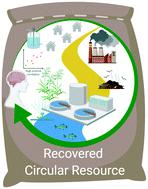当前位置:
X-MOL 学术
›
Environ. Sci.: Water Res. Technol.
›
论文详情
Our official English website, www.x-mol.net, welcomes your
feedback! (Note: you will need to create a separate account there.)
Responsible science, engineering and education for water resource recovery and circularity
Environmental Science: Water Research & Technology ( IF 3.5 ) Pub Date : 2020-06-29 , DOI: 10.1039/d0ew00402b David G. Weissbrodt 1, 2, 3, 4 , Mari K. H. Winkler 5, 6, 7, 8, 9 , George F. Wells 5, 9, 10, 11
Environmental Science: Water Research & Technology ( IF 3.5 ) Pub Date : 2020-06-29 , DOI: 10.1039/d0ew00402b David G. Weissbrodt 1, 2, 3, 4 , Mari K. H. Winkler 5, 6, 7, 8, 9 , George F. Wells 5, 9, 10, 11
Affiliation

|
Water resource recovery is central to the circular economy framework. It underlies the transition of environmental engineering from pollution prevention to responsible innovation for sustainable systems engineering. In order to speed this transition, resource recovery and circularity need integration into new higher education curricula to train the next generation of young professionals. However, training of new concepts requires the development of new course materials and books, while integrating substantial illustrations and problems on circularity and resource recovery in new editions of existing textbooks in environmental science and engineering. Moreover, university–utility–industry partnerships are important mechanisms to bridge theoretical fundamentals to concepts for engineering practice, and to promote knowledge exchange and technology adoption between practitioners and academics. Interactive platforms should be designed to facilitate the integration and development of resource recovery and circularity concepts from science and practice into education. Consensus was built on this perspective article from interaction with the members of the Association of Environmental Engineering and Science Professors in a workshop that we organized at the AEESP Research and Education Conference 2017. Overall, this paper gives actionable roadmaps to (i) apprehend how new science and technological findings need to get integrated to sustain resource recovery and circularity in practice, along with the fact that (ii) skills sets can be engineered with relatively minor changes to existing lecture material that will have maximal impact on the scope of the thought material. It lays out (iii) how partnership with engineering practitioners can make a lecture more vivid by giving students reasoning for why the learned material is important, and (iv) how a platform for an integrated science, education, and practice can deliver them with concrete tools for practical implementation for benefits at community level.
中文翻译:

负责水资源恢复和循环的科学,工程和教育
水资源回收对于循环经济框架至关重要。它是环境工程从污染预防到负责任的可持续系统工程创新的过渡的基础。为了加快这一转变,需要将资源恢复和循环利用纳入新的高等教育课程中,以培训下一代年轻专业人员。但是,对新概念的培训需要开发新的课程材料和书籍,同时在环境科学和工程领域的现有教科书的新版本中整合有关循环性和资源回收的大量插图和问题。此外,大学-实用工具-工业伙伴关系是将理论基础与工程实践概念联系起来的重要机制,并促进从业者和学者之间的知识交流和技术采用。应设计互动平台,以促进从科学和实践到教育的资源回收和循环性概念的整合和发展。共识是基于此观点文章而建立的,该观点是在我们于2017年AEESP研究和教育会议上组织的研讨会中与环境工程与科学教授协会的成员进行互动的。总体而言,本文为(i)理解新方法提供了可行的路线图。需要整合科学和技术发现,以在实践中维持资源的恢复和循环,(ii)可以通过对现有授课材料进行相对较小的更改来设计技能集,这将对思维材料的范围产生最大影响。它阐述了(iii)与工程从业者的合作如何通过让学生推理所学材料为何如此重要来使演讲更加生动,以及(iv)综合科学,教育和实践的平台如何为他们提供具体的信息切实执行的工具,以在社区一级带来收益。
更新日期:2020-07-31
中文翻译:

负责水资源恢复和循环的科学,工程和教育
水资源回收对于循环经济框架至关重要。它是环境工程从污染预防到负责任的可持续系统工程创新的过渡的基础。为了加快这一转变,需要将资源恢复和循环利用纳入新的高等教育课程中,以培训下一代年轻专业人员。但是,对新概念的培训需要开发新的课程材料和书籍,同时在环境科学和工程领域的现有教科书的新版本中整合有关循环性和资源回收的大量插图和问题。此外,大学-实用工具-工业伙伴关系是将理论基础与工程实践概念联系起来的重要机制,并促进从业者和学者之间的知识交流和技术采用。应设计互动平台,以促进从科学和实践到教育的资源回收和循环性概念的整合和发展。共识是基于此观点文章而建立的,该观点是在我们于2017年AEESP研究和教育会议上组织的研讨会中与环境工程与科学教授协会的成员进行互动的。总体而言,本文为(i)理解新方法提供了可行的路线图。需要整合科学和技术发现,以在实践中维持资源的恢复和循环,(ii)可以通过对现有授课材料进行相对较小的更改来设计技能集,这将对思维材料的范围产生最大影响。它阐述了(iii)与工程从业者的合作如何通过让学生推理所学材料为何如此重要来使演讲更加生动,以及(iv)综合科学,教育和实践的平台如何为他们提供具体的信息切实执行的工具,以在社区一级带来收益。











































 京公网安备 11010802027423号
京公网安备 11010802027423号